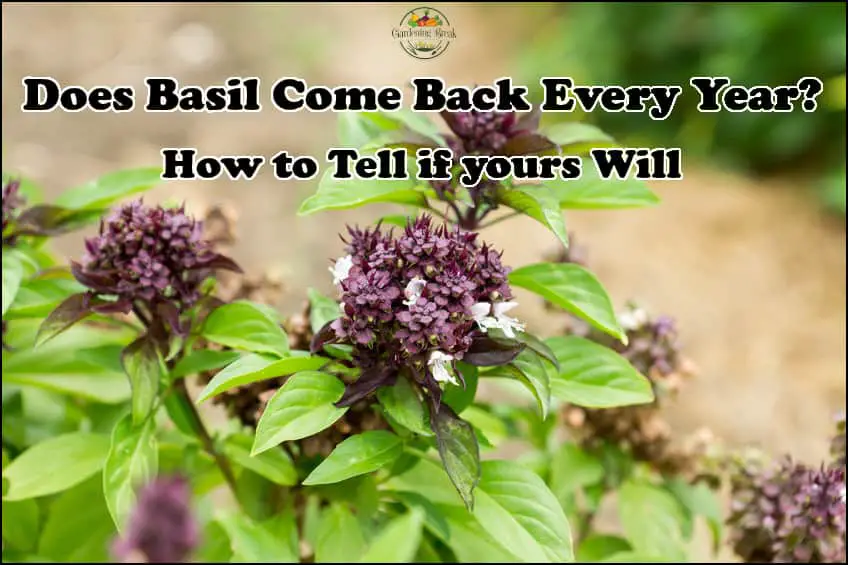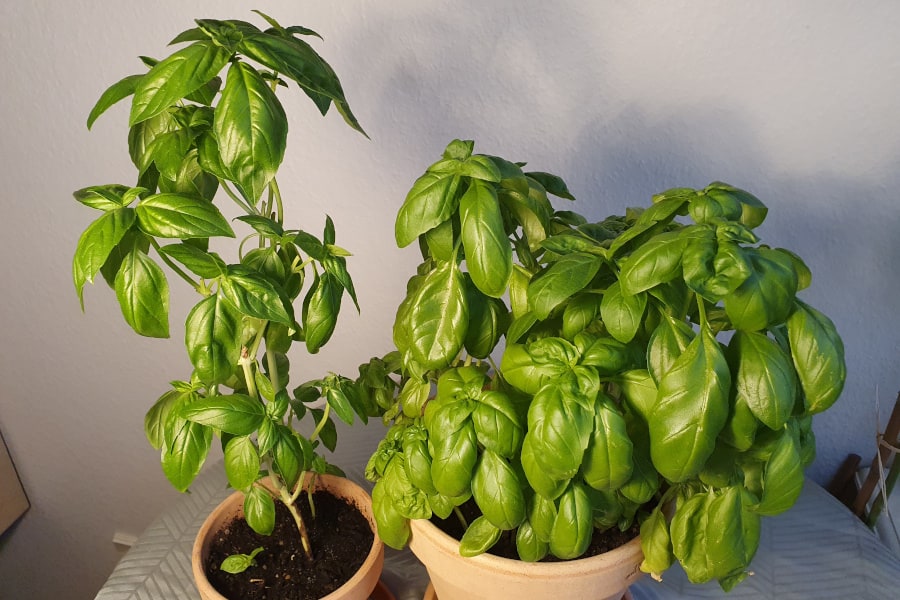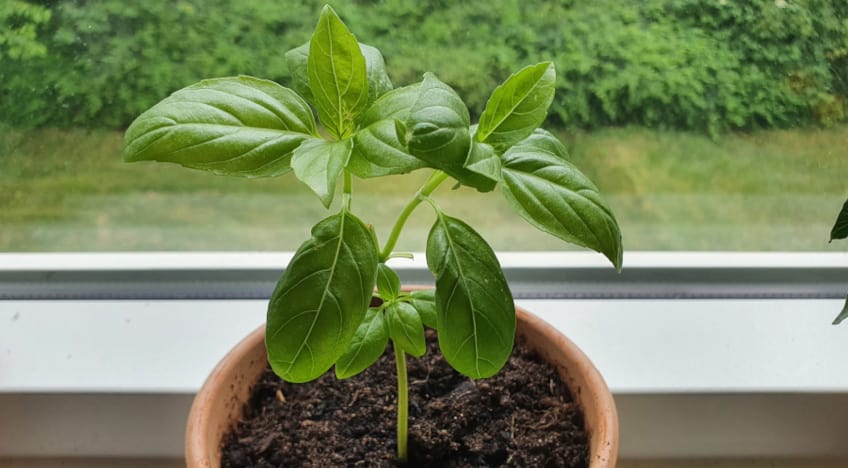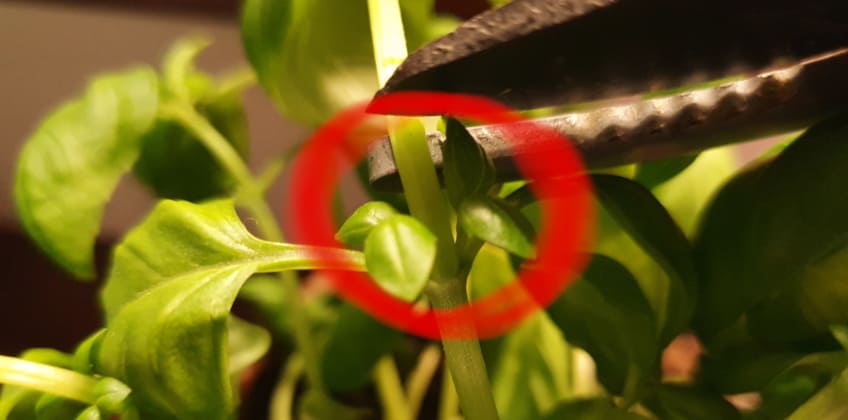Some herbs live only for a single season, and some come back year after year. So which category does basil belong to? Does basil come back every year, or does it only live for one season? The answer is actually a bit nuanced, so I have written this article to explain it.
Most basil varieties do not come back every year since they are annuals, which means that they only live for a single season. There are, however, a handful of perennial basil varieties that will come back since they can live for multiple years as long as they have the right growing conditions.

In this article, I explain why some basil varieties come back after the winter and others don’t. I have also done my best to help you figure out if your specific basil plant will come back by helping you figure out which variety you have if you don’t already know.
I also share four examples of perennial basil varieties you can grow if you want some that come back every year and some tips you can follow to help your basil survive for many years. Lastly, I share a method for harvesting basil so that it grows back multiple times within the same growing season.
Does Basil Come Back Every Year? Full Explanation
Whether or not a basil plant comes back every year depends on several things. Mainly on the variety of the basil plant since some are annuals that only live for one season and others are perennials that live for several years.
No basil plant can live forever, but some are perennials that can live for several years. That said, most basil varieties, including the most common ones, are annuals that will only live for a single season.
Basil can technically reseed itself and grow back that way, although the seeds cannot withstand frost for long periods of time. So basil can’t reseed itself and grow back next year in most parts of the world, but in very warm areas that don’t get frost in the winter, basil can absolutely reseed itself and grow back. You can read more about that here.
The annual basil varieties generally die in the fall or the winter once they are done with their reproductive cycle, which ends with them producing flowers and seeds. The perennial varieties produce flowers and seeds for more than just one season, so they will not die after completing their reproductive cycle.
If the end of the basil growing season is near, I recommend reading the article on this link, where I explain what you should do depending on what type of basil you are growing.
Basil does not do well in cold temperatures, so naturally, the temperature also plays a crucial role in whether or not it will come back every year. I will elaborate a bit on that before I get into how you can know if your specific basil will come back every year.
Coldest, Warmest, and Best Temperature for Basil Plants
As a general rule, the coldest temperature basil can survive is 50° F (about 10° C). Basil thrives at temperatures between 70-85°F (about 21-29°C), but if the temperature exceeds 90° F (32° C), the plants will typically start flowering.
So if you live in an area that gets much colder than this in the winter, your basil will not come back. That said, if you live somewhere that never (or only very rarely) gets colder than this, there is a very good chance that your basil can grow for several years (assuming it is a perennial variety).
Of course, these numbers are not laws that are cut in stone but rather a general rule of thumb. It depends a lot on each individual plant and is affected by which variety they are and how good growing conditions they have.
A potential way to keep your basil alive through the winter if you live somewhere cold is to grow your basil indoors or take it inside in the winter. That being said, since the plant is native to the Mediterranean region, it expects colder temperatures in the winter than in the summer, so taking it inside might not work perfectly. It is definitely worth it to give it a try, though. Just keep in mind that there are several differences between growing basil indoors and outside. You can read more about that on this link.
Now that you know a bit about why some basil varieties come back for several years and why some don’t, it is time to figure out if your specific basil plant will come back. Let’s get into it.
How to Tell if Your Basil Plant Will Come Back Next Year
Most basil plants will not come back the year after it was planted since they are annuals (meaning they only live for one season), but some can come back for several years. I wrote this part of the article to help you figure out if your specific basil plant will come back or not.
Of course, I can’t tell you with certainty if your basil plant will come back next year since I don’t know the variety, how good growing conditions it has, or where in the world you live. That said, I have a bunch of great tips you can use to figure it out if it will come back.

Most of the common basil varieties do not come back after the winter. The most commonly grown basil variety is probably Genovese basil, which is also often referred to as Sweet basil. I have grown Genovese basil for many years. It is the one you can see in the photo above, where I grew a single plant in the pot on the left and several plants in the pot on the right to see the difference.
Genovese basil is an annual variety that doesn’t grow back next year, so it has to be planted every year.
So if your basil plant looks like mine in the photo above, it probably won’t come back next year. There are other basil varieties that look very similar to Genovese basil, but most of them are also annuals.
I have found four common and popular perennial basil varieties that come back every year for several years. If your basil plant is one of these varieties, it should live for several years. More on that below.
Basil Varieties That Come Back Every Year (4 Varieties)
Perennial plants are plants that can live for multiple years. Most basil varieties are annual, meaning they only live for one season, but there is also a handful of perennial ones.
I have found four of the most common and popular perennial basil varieties. I have grown one of them before with great success, although I wasn’t able to keep it alive for more than one season since it got too cold in the winter. You can read more about how long basil plants can live and how you can extend their lifespan on this link.

Here are the four perennial basil varieties:
Greek basil
Greek basil is very unique. It grows as a small but very dense and bushy shrub with many leaves that are much smaller than the more common Genovese basil.
I have grown Greek basil before and really enjoyed it since it is very aesthetically pleasing to look at and very well-tasting.
Thai basil
You can recognize Thai basil on the leaves. They are more pointy and less shiny than the leaves on the more common Genovese basil. When Thai basil flowers, it produces beautiful purple flowers.
Thai basil has a slightly more spicy and licorice-like taste than Genovese basil.
Perennial basil
Perennial basil looks very similar to Thai basil but generally has smaller leaves. The plant can get really large and produce a ton of pollinator-attracting flowers under the right conditions.
The flowering basil plant in the photo above is of the variety Perennial Basil.
Holy basil
Holy basil, also often called Tulsi, is native to the Indian subcontinent and is very common in Southeast Asia. The leaves are much less shiny than Genovese basil leaves but about the same size.
Since Thai basil and Perennial basil are both very popular but also similar, I found this video from one of my absolute favorite gardening-oriented youtube channels, Self Sufficient Me, where Mark, the fantastic host, explains a bit about the two varieties.
Now that you know about some perennial basil varieties, I want to share a couple of easy but really effective tricks that can help you keep your basil alive for multiple years.
Easy Things You Can Do to Help Your Basil Survive Winters
Only perennial basil varieties can survive for more than one growing season, but it takes more than a perennial variety to be able to keep a basil plant alive for multiple years. It also requires knowledge about how to take care of the plant.
Here are some simple but very effective (and necessary) things you should know in order to keep a basil plant alive for multiple growing seasons.
Know how to solve common basil problems
There are a bunch of different potential issues you can run into when growing basil. Some of them will be minor and be solved without you doing anything, but some of them are more serious and requires action from you. Therefore, I have written this article where I explain how to solve 12 common problems people run into when growing basil, including how to get rid of bad insects, how to stop over- or underwatering the plant, and a lot more.
Know how to make the plant thrive
If a basil plant has good growing conditions, it can grow and produce leaves at a very fast rate, so you want to get as close to the optimal conditions as possible. That said, you should definitely not give up on growing basil just because you can’t provide it with the ideal conditions.
Basil needs warm weather, lots of sunlight, and nutrient-rich and well-drained soil that stays moist without getting dry or too wet to thrive. This may sound a bit complicated and difficult, but it is honestly not that hard. You can read much more about what conditions basil grows best under in this article, where I also share a bunch of tips to help with achieving the best conditions.
Keep Your Basil Alive for Longer by Taking Cuttings
I have talked a lot about what basil varieties can live for the longest time and what you can do to help your basil live longer, but I have one more tip that can help any basil plant live for a lot longer than it otherwise would.
The tip I want to share with you is that you can take cuttings from your basil plant and grow them as their own plant. Sure, it is technically not the same as keeping a single plant alive, but since the cutting comes from the original plant, I think it still counts.

“Taking cuttings” basically just means that you cut a piece off one plant and grow it as its own.
To grow basil from cuttings, cut a stem that is at least 5 inches (12.5 cm) long just above a leaf node. Strip the stem of any leaves except the four at the top and place the cutting in a glass with water so that the stem is submerged, but the leaves are above water. Wait 1-2 weeks while changing the water every day, and roots should appear along the stem. When that happens, you can plant it in soil like any other plant.
I have a much more thorough guide to growing basil from cuttings where I explain each step in a lot more detail, so you know precisely how to do it. You can find the article here.
The photo above shows a basil plant I grew a few years ago from a cutting from another plant, but since it is a Genovese basil, which is an annual, I don’t have it any longer.
Continuously taking cuttings is a great way to keep a basil plant alive for longer and to get more basil for free. Using the correct harvesting method can make the plant grow back bigger and bushier than before, so if you combine that with continuously taking cuttings, you can really take your basil production to the next level.
Below, I will teach you how to harvest your basil, so it comes back over and over again and gets bigger and bushier every time.
Harvesting Basil So It Grows Back Bigger Than Before
A lot of people talk about “picking” basil leaves, and while that, of course, works if what you need is some basil leaves, there is a much better way to harvest basil. Proper harvesting is the key to getting the most out of your basil plants, so keep reading.
If you use the harvesting method I am going to teach you now, your basil will keep growing back over and over again within the same season and come back bigger and bushier every time.

The best way to harvest basil is to cut or pinch off stems or new shoots about half an inch to an inch (about 1.25-2.5 cm) above a leaf node. Doing so causes two new stems to grow from the leaf node, essentially doubling the production.
I took the photo above of one of my basil plants and drew a red circle around the leaf node to show you precisely where you should cut.
Cut or pinch off only what you need and then just pick the leaves off the stems you took. Next time you need some fresh basil, cut some other stems, so the stems you cut have time to grow back.
You can also just cut back the whole plant by about half if you need a lot of basil. Just try to cut above the leaf nodes like I explained since that will make the plant come back much bigger and bushier than before.
The leaf nodes contain a large amount of growth hormone, so when you cut the stem just above them, the leaf nodes will start growing into two new stems, which makes the plant much bushier overall and also a lot more productive since there are a lot more stems.
You can read my full guide to harvesting basil on this link, where I also share four ways to store it for later.
Read My Complete Guide to Growing and Caring for Basil
I have written a thorough guide where I cover all parts of growing your own basil including choosing a variety, sowing the seeds, the best growing conditions, pruning, propagation, harvesting, storing, solving various problems, and a lot more. You can find the article on this link.

